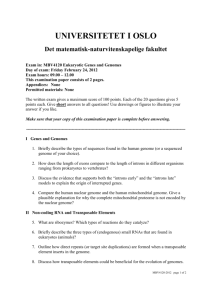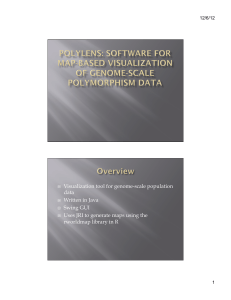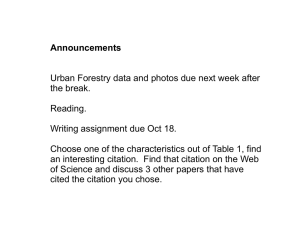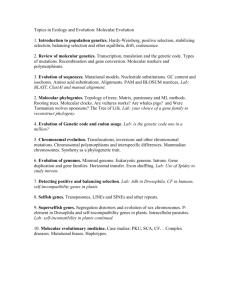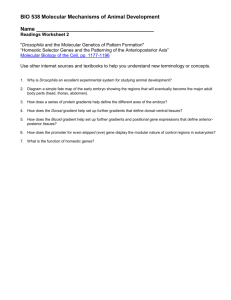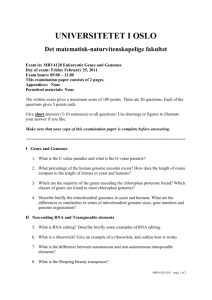First Day Overview Power-point
advertisement
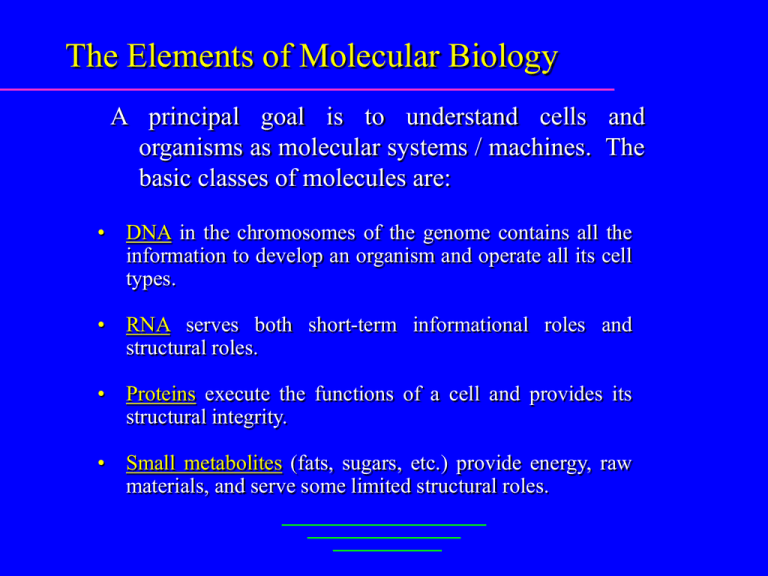
The Elements of Molecular Biology A principal goal is to understand cells and organisms as molecular systems / machines. The basic classes of molecules are: • DNA in the chromosomes of the genome contains all the information to develop an organism and operate all its cell types. • RNA serves both short-term informational roles and structural roles. • Proteins execute the functions of a cell and provides its structural integrity. • Small metabolites (fats, sugars, etc.) provide energy, raw materials, and serve some limited structural roles. Cells As Molecular Machines Cell Nucleus Genome Polymerase Gene TBF mRNA Transcription Splicing Transport Signal Cascade Ribosome Protein Translation Activation Receptor Secretion Metabolics: Synthesis Degradation Energy Understanding Cells at the Molecular Level Determining the DNA sequences of the chromosomes of a species. Sequencing An accurate parts list of all the proteins and RNAs in the cell. Annotation A graph of all the interactions taking place between these agents. Pathways What is happening during each interaction. Function Where each interaction is taking place. Subcellular Localization Simulating the system to predict behavior. Cellular Dynamics Current State We can sequence the euchromatic portions of genomes. We can recognize 75% of the genes but not accurately unless they have been experimentally verified. We don’t know much about alternate splicing. We can crudely observe expression of mRNAs and with even greater difficulty observe the more abundant proteins. Most accurate molecular biological information is still being verified one hypothesis at a time. We must either coordinate efforts or reduce experimental costs to the point where each investigator is greatly empowered. Current Technologies Sequencing: Randomly sample and sequence 600bp stretches from the ends of segments of a given length and assemble, followed by a directed finishing phase. Expression Assays: High density arrays where each spot is a set of 18-50bp DNAs complementary to the RNA sequence to be measured, or geometric amplification from a pair of DNA probes complementary to the RNA sequence (quantitative PCR). Proteomics: Mass spectrometers can measure the amount and atomic weight of ionized protein pieces (peptides) allowing complex mixtures to be analyzed. Light Microscopy: With confocal microscopes and antibody, or RNA, or organometallic staining, phenomenon involving but a few particles are being observed. All of these technologies involve interesting problems in the interpretation of the data. Data Analysis vs. Data Mining On Systems Biology The goal is to understand cells and organisms as molecular systems. An objective that can be reached in the next 10-25 years is the elucidation of the topology of the “circuit” diagram of a species’ cells. A graph whose nodes are proteins, RNAs, DNAs, and metabolites Edges or hyper edges describe relationships, e.g. • Catalyzes A->B, Kinase (adds phosphate group), Complexes with, etc. Nodes carry attributes describing where and when the agent is present Believe that such knowledge will result in tremendous “understanding” in that it will generate many hypotheses that are true. Many “circuits” when modeled as stochastic diff. eq.s are so robust to their parameters that they have only a handful of operating ranges and the biologically relevent one(s) is readily evident. Apoptosis: Programmed cell death A Proposal based on Drosophila Goal: Develop a comprehensive set of accurate genomics-based data and biological resources for the advancement of cellular biology. Make them openly and readily accessible and available to all. 1. Sequence 10-20 species of Drosophila, 3-5 to a nearly-finished state and 10-15 to an assembled state. 2. Understand the evolution of the genomes and accurately annotate the genes and regulatory signals using comparative informatics. 3. Develop a comprehensive, experimentally verified annotation of all possible transcripts of the nearly-finished species. Capture each in a gate-way clone library. 4. Build state of the art expression assays for these genomes and apply them in a number of surveys. 5. Utilize mass spec. technology to begin systematically exploring complex formation and signalling cascades of Drosophila cells. Why Drosophila? Sufficiently interesting model: development, differentiation, behavior Easy to stock lines and many experimental methods. Compact genome: 20 Dros. Genomes = 1 mammalian genome Excellent evolutionary and molecular model for humans Large community: coordinated efforts are possible Comparative Gene Finding Require ab initio models to predict orthologs consistent with the evolutionary ladder amongst all strains. 40M 30M 20M sechellia mauritiana simulans melanogaster orena teissieri yakuba mimetica pseudoobscura 10M 0M Given a ladder of 5-10 Drosophila genomes we should be able to accurately discern most protein encoding genes, many RNA genes, and a host of regulatory signals The Role of Informatics We need to make computers easier to program – i.e. we need to put scientific computing in the hands of the scientists. Our information management technologies are inadequate – huge data sets, semi-structured, data contains errors, not integrated – we need to model these and develop flexible data mining capabilities over them. There will be a continued need for new algorithms and tools as driven by new technologies and protocols. Physical simulations systems of various types will be needed – docking, ligand binding, stochastic differential equations. Experimental design, driven by analysis and simulation, should be a part of our discipline and is an area where we can but are not contributing.
